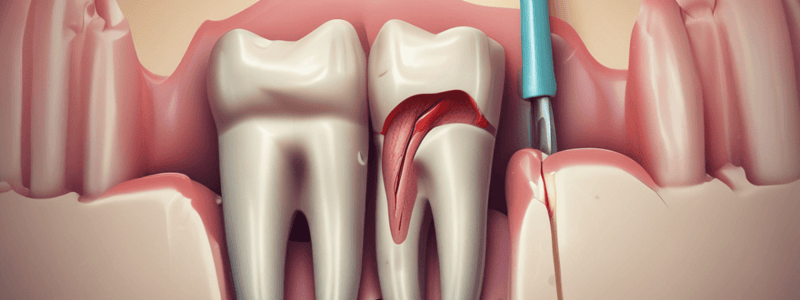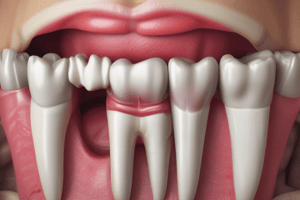Podcast
Questions and Answers
What is the main purpose of the STEP-BACK Technique?
What is the main purpose of the STEP-BACK Technique?
- To widen the root canal
- To increase the working length
- To prepare the apical constriction
- To reduce the incidence of preparation errors (correct)
How many phases does the STEP-BACK Technique consist of?
How many phases does the STEP-BACK Technique consist of?
- Four
- Two (correct)
- One
- Three
What is the Initial Apical File (IAF) used for?
What is the Initial Apical File (IAF) used for?
- To set the working length (correct)
- To widen the canal
- To irrigate the canal
- To remove debris
What is the Master Apical File (MAF)?
What is the Master Apical File (MAF)?
What is the purpose of Recapitulation?
What is the purpose of Recapitulation?
In Phase II, how much shorter is the working length for each subsequent instrument?
In Phase II, how much shorter is the working length for each subsequent instrument?
Why is it important not to skip instrument sizes?
Why is it important not to skip instrument sizes?
What is essential to do between placing each larger instrument?
What is essential to do between placing each larger instrument?
What is the primary goal of root canal treatment?
What is the primary goal of root canal treatment?
What is the purpose of shaping in root canal treatment?
What is the purpose of shaping in root canal treatment?
What is the purpose of cleaning in root canal treatment?
What is the purpose of cleaning in root canal treatment?
What is the recommended instrument for removing pulp tissue in sufficiently wide and straight canals?
What is the recommended instrument for removing pulp tissue in sufficiently wide and straight canals?
What is the function of barbed broach in removing pulp tissue?
What is the function of barbed broach in removing pulp tissue?
What is the purpose of irrigating solutions in root canal treatment?
What is the purpose of irrigating solutions in root canal treatment?
What is the result of using endodontic instruments in root canal treatment?
What is the result of using endodontic instruments in root canal treatment?
What is the characteristic of a well-shaped root canal?
What is the characteristic of a well-shaped root canal?
What is the primary purpose of the step-back technique?
What is the primary purpose of the step-back technique?
What is the primary difference between the standard technique and the step-back technique?
What is the primary difference between the standard technique and the step-back technique?
What is the purpose of using a No. 15 file in Step One of the passive step-back technique?
What is the purpose of using a No. 15 file in Step One of the passive step-back technique?
What is the purpose of using Gates-Glidden drills in Step Three of the passive step-back technique?
What is the purpose of using Gates-Glidden drills in Step Three of the passive step-back technique?
What is the purpose of using Peeso reamers in Step Four of the passive step-back technique?
What is the purpose of using Peeso reamers in Step Four of the passive step-back technique?
What is the purpose of using the step-back technique?
What is the purpose of using the step-back technique?
What is the purpose of using No. 10 or 15 K-type files in Step Two of the passive step-back technique?
What is the purpose of using No. 10 or 15 K-type files in Step Two of the passive step-back technique?
What is the purpose of using a No. 2 Gates-Glidden drill in Step Three of the passive step-back technique?
What is the purpose of using a No. 2 Gates-Glidden drill in Step Three of the passive step-back technique?
What happens immediately after the instrument is withdrawn from the canal space?
What happens immediately after the instrument is withdrawn from the canal space?
What is an advantage of using rotary systems?
What is an advantage of using rotary systems?
What is a disadvantage of using rotary systems?
What is a disadvantage of using rotary systems?
What is the purpose of pressing the MAF tip firmly against each wall on the outstroke?
What is the purpose of pressing the MAF tip firmly against each wall on the outstroke?
What is the primary criterion for evaluating canal preparation?
What is the primary criterion for evaluating canal preparation?
What is the purpose of using a file smaller than the MAF at the working length?
What is the purpose of using a file smaller than the MAF at the working length?
What is an example of a rotary system?
What is an example of a rotary system?
What is the significance of Recapitulation and irrigation between each instrument size?
What is the significance of Recapitulation and irrigation between each instrument size?
What is the primary material used in the manufacturing of hand files and engine-driven instruments?
What is the primary material used in the manufacturing of hand files and engine-driven instruments?
What is the primary purpose of using a small hand file (No. 10 stainless steel) in the canal?
What is the primary purpose of using a small hand file (No. 10 stainless steel) in the canal?
What is the term used to describe securing an open pathway to the canal terminus?
What is the term used to describe securing an open pathway to the canal terminus?
What is the typical minimum glide path size required?
What is the typical minimum glide path size required?
What is the primary purpose of rotary instrumentation?
What is the primary purpose of rotary instrumentation?
What type of motor system is used with NiTi rotary instruments?
What type of motor system is used with NiTi rotary instruments?
What is the purpose of using lubrication during rotary instrumentation?
What is the purpose of using lubrication during rotary instrumentation?
What is the unique design of NiTi rotary instruments that resembles a Gates-Glidden drill?
What is the unique design of NiTi rotary instruments that resembles a Gates-Glidden drill?
Flashcards are hidden until you start studying
Study Notes
Cleaning and Shaping the Root Canal System
- The aim of root canal treatment is to reduce microbial contamination and entomb remaining microorganisms with an effective three-dimensional seal.
Cleaning
- The purpose of cleaning is to remove all intracanal material, including vital or necrotic pulp tissue and microorganisms, from the root canal system.
- Barbed broach is recommended for removing vital pulp tissue in sufficiently wide and straight canals.
- Necrotic pulp tissue and microorganisms are removed using irrigating solutions and the mechanical action of endodontic instruments.
Shaping
- The shape of the root canal should be a continuously tapering funnel from the apex to the access cavity.
- The STEP-BACK Technique is used to prepare the canal, dividing it into two phases: apical preparation and preparation of the remainder of the canal.
- Phase I involves using an Initial Apical File (IAF) and subsequent larger files to widen the canal, and Phase II involves stepping back with larger instruments while increasing the instrument size.
Passive Step-Back Technique
- This technique uses a combination of hand instruments (files) and rotary instruments (Gates-Glidden drills and Peeso reamers) to achieve adequate coronal flare before apical root canal preparation.
Rotary Instrumentation
- The introduction of NiTi alloy for manufacturing hand files and engine-driven instruments has altered canal shaping procedures drastically over the past two decades.
- NiTi rotary file systems have been developed by different manufacturers, and various designs of NiTi instruments are available.
- Techniques using NiTi rotary instruments include the step-back and crown-down methods, and a glide path is established before rotary instrumentation.
Evaluation Criteria
- There are three criteria for evaluating canal preparation: debridement, taper, and apical preparation.
Studying That Suits You
Use AI to generate personalized quizzes and flashcards to suit your learning preferences.




